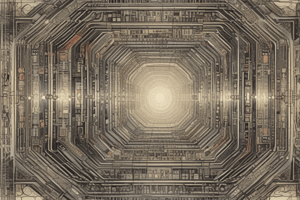Podcast
Questions and Answers
Which of the following is the most accurate definition of a distributed system?
Which of the following is the most accurate definition of a distributed system?
- A single computer that appears as multiple systems to users.
- A collection of independent computers that appears to its users as a single coherent system. (correct)
- A system with multiple interconnected CPUs working in isolation.
- A system where all computers share the same memory space.
What benefit is primarily achieved through resource sharing in distributed systems?
What benefit is primarily achieved through resource sharing in distributed systems?
- Simplified distribution-aware programming languages.
- Cost-effectiveness due to better price-performance ratio. (correct)
- Improved security and privacy.
- Reduced network connectivity requirements.
Which of the following is a primary concern related to distributed systems?
Which of the following is a primary concern related to distributed systems?
- Guaranteed data consistency.
- Centralized control.
- Network connectivity. (correct)
- Homogeneous hardware.
What type of transparency in a distributed system hides where a resource is located?
What type of transparency in a distributed system hides where a resource is located?
What is the primary purpose of 'failure transparency' in a distributed system?
What is the primary purpose of 'failure transparency' in a distributed system?
What is a key characteristic of 'open distributed systems'?
What is a key characteristic of 'open distributed systems'?
Which approach is a good method to avoid scalability problems in distributed systems?
Which approach is a good method to avoid scalability problems in distributed systems?
Which characteristic related to decentralized algorithms ensures system resilience?
Which characteristic related to decentralized algorithms ensures system resilience?
In the context of distributed systems, what is the primary function of the 'workstation model'?
In the context of distributed systems, what is the primary function of the 'workstation model'?
Which model describes a scenario where terminals connect to a pool of backend processors for handling processing tasks?
Which model describes a scenario where terminals connect to a pool of backend processors for handling processing tasks?
What is a defining characteristic of 'Distributed Pervasive Systems'?
What is a defining characteristic of 'Distributed Pervasive Systems'?
What is the core role of an operating system in the context of a uniprocessor system?
What is the core role of an operating system in the context of a uniprocessor system?
How does a 'distributed operating system' present itself to the user?
How does a 'distributed operating system' present itself to the user?
Which of the following best describes the main goal of a Network Operating System (NOS)?
Which of the following best describes the main goal of a Network Operating System (NOS)?
In multiprocessor operating systems, what is a primary challenge related to hardware caches?
In multiprocessor operating systems, what is a primary challenge related to hardware caches?
Flashcards
Distributed System
Distributed System
Multiple connected CPUs working together that appear as a single coherent system to users.
Scalability
Scalability
Being able to grow and adapt as needed.
Advantages of Distributed Systems
Advantages of Distributed Systems
Communication and resource sharing are possible alongside potential growth.
Disadvantages of Distributed Systems
Disadvantages of Distributed Systems
Signup and view all the flashcards
Transparency: Access
Transparency: Access
Signup and view all the flashcards
Transparency: Location
Transparency: Location
Signup and view all the flashcards
Transparency: Migration/Relocation
Transparency: Migration/Relocation
Signup and view all the flashcards
Transparency: Replication
Transparency: Replication
Signup and view all the flashcards
Transparency: Concurrency
Transparency: Concurrency
Signup and view all the flashcards
Transparency: Failure
Transparency: Failure
Signup and view all the flashcards
Transparency: Persistence
Transparency: Persistence
Signup and view all the flashcards
Open Distributed Systems
Open Distributed Systems
Signup and view all the flashcards
Decentralized Algorithms Principles
Decentralized Algorithms Principles
Signup and view all the flashcards
Scaling Techniques
Scaling Techniques
Signup and view all the flashcards
Processor pool model
Processor pool model
Signup and view all the flashcards
Study Notes
Definition of a Distributed System
- A distributed system involves multiple connected CPUs working together.
- It appears to users as a single, coherent system, although it consists of independent computers.
- Parallel machines and networked machines are examples of distributed systems.
Advantages and Disadvantages
- Advantages include the possibility of communication, resource sharing, a good price-performance ratio, reliability, scalability, and potential for incremental growth.
- Disadvantages include the need for distribution-aware programming languages, operating systems, and applications, as well as essential network connectivity, security, and privacy considerations.
Transparency in a Distributed System
- Access transparency hides differences in data representation and how a resource is accessed.
- Location transparency hides where a resource is located.
- Migration transparency hides that a resource may move to another location.
- Relocation transparency hides that a resource may be moved to another location while in use.
- Replication transparency hides that a resource may be replicated.
- Concurrency transparency hides that a resource may be shared by several competitive users.
- Failure transparency hides the failure and recovery of a resource.
- Persistence transparency hides whether a software resource is in memory or on disk.
Open Distributed Systems
- Open distributed systems offer services described a priori
- Syntax and semantics are known through protocols.
- Services are specified via interfaces, offering benefits like interoperability and portability.
- Open systems should evolve over time, be extensible to new functionality, and separate policy from mechanism.
Scalability Problems
- Centralized services, such as a single server for all users, can cause scalability problems.
- Centralized data, like a single on-line telephone book, can limit scalability.
- Centralized algorithms, such as doing routing based on complete information, can hinder scalability.
Scaling Techniques
- Principles for good decentralized algorithms include no machine having complete state.
- Decisions should be based on local information, and a single failure should not bring down the entire system.
- No global clock is needed.
- Techniques include asynchronous communication, distribution, and caching and replication.
Module 3: Distributed Systems History and OS Models
- Minicomputer model with early networks: each user has a local machine and can fetch remote data.
- Workstation model uses Sprite, allowing processing to migrate.
- Client-server Model: Users have a local workstation, and powerful workstations serve as servers.
- Processor pool model: Terminals are Xterms, and a pool of backend processors handles processing.
Distributed System Models (contd)
- Cluster computing systems/Data centers consist of LAN with a cluster of servers plus storage (e.g., Linux, Mosix).
- Used by distributed web servers, scientific applications, and enterprise applications.
- Grid computing systems: a cluster of machines connected over a WAN, such as SETI @ home.
- WAN-based clusters/distributed data centers include Google and Amazon.
- Virtualization and data centers are used.
- Cloud Computing is also implemented.
Emerging Models
- Distributed Pervasive Systems are emerging with smaller nodes that have networking capabilities.
- Computing is everywhere,
- Home networks include TiVO and Windows Media Center and mobile computing includes smart phones, iPads, and car-based PCs.
- Sensor networks and health-care/personal area networks are utilized.
- Sustainability is considered as a design goal.
Uniprocessor Operating Systems
- An OS acts as a resource manager or an arbitrator and manages CPU, I/O devices, and memory.
- The OS provides a virtual interface that is easier to use than hardware.
- Structure of uniprocessor operating systems can be monolithic (e.g., MS-DOS, early UNIX) with one large kernel.
- Layered design decomposes functionality into N layers, where each layer uses services of layer N-1 and implements new service(s) for layer N+1.
Microkernel Operating Systems
- Microkernel architecture features a small kernel, and user-level servers implement additional functionality.
- There is no direct data exchange between modules.
Distributed Operating System
- It manages resources in a distributed system seamlessly and transparently to the user.
- The system appears like a centralized OS but operates on multiple independent CPUs.
- It provides transparency in location, migration, concurrency, and replication.
- It presents users with a virtual uniprocessor.
Types of Distributed OSs
- DOS (Distributed Operating System) is a tightly coupled operating system for multi-processors and homogeneous multicomputers, with the goal of hiding and managing hardware resources.
- NOS (Network Operating System) is a loosely coupled operating system for heterogeneous multicomputers (LAN and WAN), offering local services to remote clients.
- Middleware is an additional layer atop of NOS, implementing general-purpose services and providing distribution transparency.
Multiprocessor Operating Systems
- It is like a uniprocessor operating system that manages multiple CPUs transparently to the user.
- Each processor has its own hardware cache, and the system maintains consistency of cached data.
Network Operating System
- Employs a client-server model.
- Minimal OS kernel.
- Additional functionality as user processes.
Middleware-based Systems
- General structure of a distributed system as middleware.
Studying That Suits You
Use AI to generate personalized quizzes and flashcards to suit your learning preferences.




